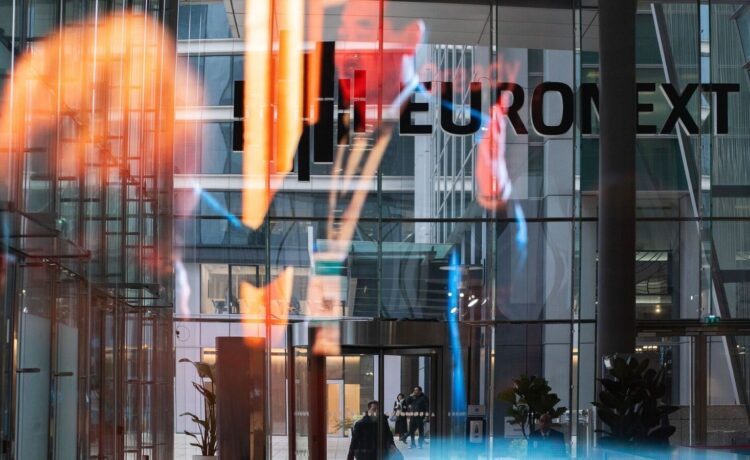The German DAX has climbed more than 9% this year in dollar terms, and France’s CAC 40 is up about 8%. That is well above the 2.45% gain in the S&P 500. European indexes haven’t outpaced U.S. counterparts by such a wide mark at the start of a year since 2015, according to Dow Jones Market Data.
Some of the world’s best-performing large stocks this year include European banks like Société Générale and Banco Santander, and the luxury houses Burberry and Richemont.
The enthusiasm comes at an unlikely time. The eurozone ended 2024 with zero economic growth, and Trump said this week that he would hit the European Union “pretty soon” with tariffs, after initially focusing on Canada, Mexico and China.
And yet, a confluence of factors is boosting European markets.
Investors had expected Trump’s return to the White House would cement U.S. stock outperformance. But that belief has been shaken, after the rise of Chinese artificial-intelligence upstart DeepSeek and lackluster earnings from heavyweights such as Alphabet and Microsoft. In turn, that has pushed investors to reconsider unloved markets like those in Europe and Asia.
Meanwhile, the political, economic and profit outlook for Europe is improving, while hopes that Trump will negotiate a cease-fire between Ukraine and Russia have also boosted stocks, particularly in Eastern Europe.
“Europe was treated like it was almost uninvestible,” said Luca Paolini, chief strategist at Pictet Asset Management. “The sentiment on European stocks was so bad, any single positive thing would have a significant impact.”
One major draw of European indexes is that they look cheap versus U.S. counterparts. The S&P 500 trades at 22 times its projected earnings over the next 12 months, according to LSEG, compared with about 14 for the pan-continental Stoxx Europe 600 and 12 for U.K. stocks.
While that partly reflects a different split of companies and growth profiles, the relative expensiveness of U.S. stocks makes it harder for them to keep rising, some investors say. Conversely, the cheapness of European stocks should make it easier for them to gain when the mood brightens.
Some indexes have been packaged into U.S. exchange-traded funds, such as the iShares MSCI Eurozone ETF and the Vanguard FTSE Europe ETF.
It helps that profit growth is picking up. Stoxx Europe 600 companies’ per-share earnings are expected to grow 7.7% this year, according to FactSet, compared with a rise of just 2.6% in 2024.
“There are earnings prospects outside of the U.S. tech sector,” said Florian Ielpo, head of macro at Lombard Odier Investment Managers in Geneva. “This doesn’t mean U.S. equities are likely to do bad, it just means other stocks could be posting as-appealing returns.”
The strength of the U.S. economy—and the dollar—is good news for many large European companies, many of whom get more revenue from the U.S. than they do in their home market. That means they are exposed to faster American growth, while a rising dollar makes those sales worth more when translated back into euros or pounds.
Expectations that central banks in Europe will cut interest rates more aggressively than the Federal Reserve is another driver. The Bank of England and European Central Bank have cut interest rates in recent weeks, while the Fed held rates steady. Lower borrowing costs typically serve to shore up growth, and can pull more investors into the stock market.
Another major storm cloud—political uncertainty—could also be abating. France’s government this week survived a no-confidence vote, clearing a path to end its budget crisis.
Meanwhile, Germany, whose government collapsed in November, will hold elections later this month. Investors hope Berlin could finally loosen conservative budget rules, unleashing new investment to reinvigorate its faltering economy.
However, while Trump’s tariff threats have been brushed off so far by investors, they remain a major risk for the European rally, said Altaf Kassam, Europe head of investment strategy and research at State Street Global Advisors.
“The market seems to be absolutely pricing everything as a negotiation tactic,” he said. “There’s every chance that Trump sets his sights on Europe next…and that would definitely set the rally back.”
The rebound follows a long stretch of U.S. outperformance versus global markets that dates back to the global financial crisis. If an investor put $100 in the S&P 500 at the end of 2008 and reinvested dividends, it would be worth about $920 today, according to LSEG. The same amount invested in an MSCI index of European shares would now be worth about $339.
Still, some investors doubt this marks an inflection point.
“The U.S. is still the place to be,” said Paolini of Pictet. “It is difficult not to be invested in the U.S. today unless you can make the case that Europe and China will reaccelerate significantly.”
—Krystal Hur contributed to this article.
Write to Chelsey Dulaney at [email protected]














